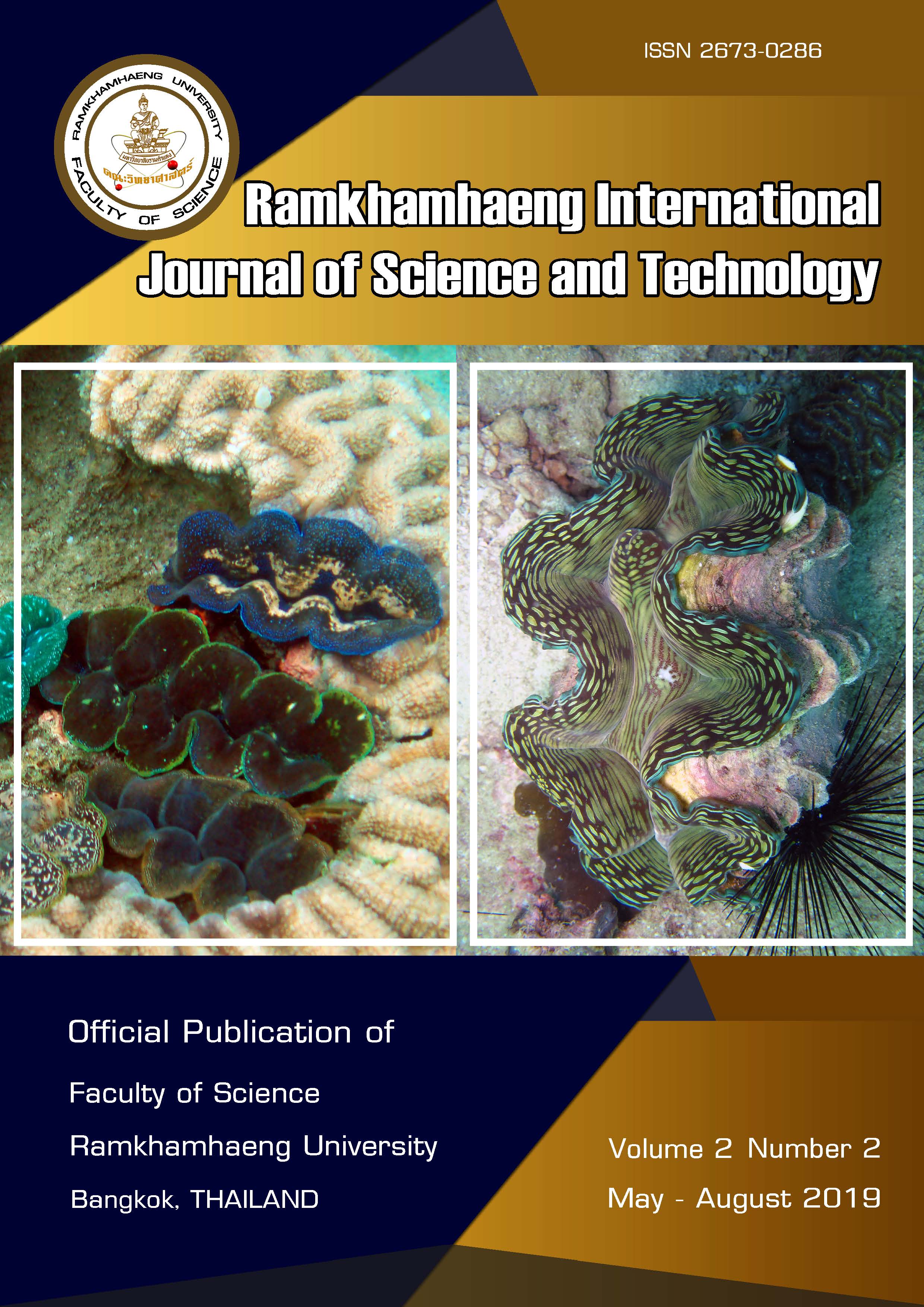Assessing abundance of the giant clams Tridacna spp. on shallow reef flats in the gulf of Thailand
Keywords:
abundance, giant clam, Gulf of Thailand, population, shallow reef flatAbstract
The giant clams are sessile reef animals that attract tourists in Thailand and other countries. In the past, giant clams represented an important component of coral communities in the Gulf of Thailand. The present study aimed to examine the population densities of the giant clams Tridacna spp. on shallow reef flats in Mu Ko Chumphon, Mu Ko Angthong, and Ko Pha-Ngan, the Gulf of Thailand. The field surveys were conducted at 23 reef sites. Two giant clam species, namely T. crocea and T. squamosa were recorded. The population of T. squamosa occupied all study sites. The highest number was found at Ko Taen (0.96±0.16 ind/m2), while the lowest was observed at Ko Mattra and Ko Lawa, Mu Ko Chumphon (0.2±0.18 and 0.2±0.17 ind/m2, respectively). In contrast, T. crocea was observed only at 2 study sites, Ao Luek in Ko Tao and Ko Hin Dab in Mu Ko Angthong. There were no records of giant clams at several study sites, particularly in Mu Ko Ang thong and Ko Pha-Ngan. The correlation analysis results indicated that there is a strong negative relationship between giant clam population density and temperature (R = -0.85), while the low positive relationship was found to transparency. The results imply that previous giant clam restoration projects can enhance population densities on natural reefs.
References
Bellwood DR, Tebbett SB, Bellwood O, Mihalitsis M, Morais RA, Streit RP, Fulton CJ (2018) The role of the reef flat in coral reef trophodynamics: Past, present, and future. Ecology and evolution 8:4108-4119
Blidberg E, Elfwing T, Plantman P, Tedengren M (2000) Water temperature influences on physiological behaviour in three species of giant clams (Tridacnidae). Proceedings of the ninth international coral reef symposium, Bali, Indonesia, pp 561-565
Brahmi C, Chapron L, Le Moullac G, Soyez C, Beliaeff B, Lazareth CE, Gaertner-Mazouni N, Vidal-Dupiol J (2019) Effects of temperature and pCO2 on the respiration, biomineralization and photophysiology of the giant clam Tridacna maxima. bioRxiv 672907
Chantrapornsyl S, Kittiwattanawong K, Adulyanukosol K (1996) Distribution and abundance of giant clam around Lee-Pae Island, the Andaman Sea, Thailand. Phuket Marine Biological Center Special Publication 16:195-200
English S, Wilkinson C, Baker V (1997) Survey manual for tropical marine resources. Australian Institute of Marine Science, Townsville, Australia, pp 378
Guest JR, Todd PA, Goh E, Sivalonganathan BS, Reddy KP (2008) Can giant clam (Tridacna squamosa) populations be restored on Singapore's heavily impacted coral reefs?. Aquatic Conservation: Marine and Freshwater Ecosystems 18:570-579
Mies M, Sumida PY (2012) Giant clam aquaculture: a review on induced spawning and larval rearing. International Journal of Marine Science 2
Mingoa-Licuanan SS, Gomez ED (2007) Giant clam hatchery, ocean nursery and stock enhancement. Aquaculture Department, Southeast Asian Fisheries Development Center.
Neo ML, Eckman W, Vicentuan K, Teo SLM, Todd PA (2015) The ecological significance of giant clams in coral reef ecosystems. Biological Conservation 181:111-123
Neo ML, Todd PA (2012a) Giant clams (Mollusca: Bivalvia: Tridacninae) in Singapore: history, research and conservation. Raffles Bulletin of Zoology 25:67-78
Neo ML, Todd PA (2012b) Population density and genetic structure of the giant clams Tridacna crocea and T. squamosa on Singapore’s reefs. Aquatic Biology 14:265-275
Norton JH, Jones GW (1992) The giant clam: an anatomical and histological atlas. Australian Center for International Agricultural Research (ACIAR) Monograph Series, Canberra, p 142
Nugranad J, Kittiwattanawong K (2016) Aquaculture-based enhancement and restoration of giant clam in Thailand. In: Kawamura H, Iwata T, Theparoonrat Y, Manajit N, Sulit VT (eds) Consolidating the Strategies for Fishery Resources Enhancement in Southeast Asia. Proceedings of the Symposium on Strategy for Fisheries Resources Enhancement in the Southeast Asian Region. Training Department, Southeast Asian Fisheries Development Center, Pattaya, Thailand, pp 171-173
Nugranad J, Traithong T, Poomtong T, Sahavacharin S (1997) Hatchery seed production of the fluted giant clam (Tridacna squamosa Lamarck, 1819) and ocean nursery of the juveniles for restocking in Koh Tao, Thailand. Phuket Marine Biological Center Special Publication 17:101-108
Othman AS, Goh GH, Todd PA (2010) The distribution and status of giant clams (family Tridacnidae)-a short review. The Raffles Bulletin of Zoology 58:103-111
Ramah S, Taleb-Hossenkhan N, Bhagooli R (2017) Differential substrate affinity between two giant clam species, Tridacna maxima and Tridacna squamosa, around Mauritius. Western Indian Ocean Journal of Marine Science 13-20
Rossbach S, Saderne V, Anton A, Duarte CM (2019) Light-dependent calcification in Red Sea giant clam Tridacna maxima. Biogeosciences 16:2635-2650
Shau-Hwai AT, Yasin Z (2003) Status of giant clams in Malaysia. SPC Trochus Information Bulletins 10:9-10
Triandiza T, Zamani NP, Madduppa H, Hernawan UE (2019) Distribution and abundance of the giant clams (Cardiidae: Bivalvia) on Kei Islands, Maluku, Indonesia. Biodiversitas Journal of Biological Diversity 20:884-892
Van Wynsberge S, Andréfouët S, Gaertner‐Mazouni N, Wabnitz CC, Gilbert A, Remoissenet G, Payri C, Fauvelot C (2016) Drivers of density for the exploited giant clam Tridacna maxima: a meta‐analysis. Fish and Fisheries 17:567-584
Waters CG, Story R, Costello MJ (2013) A methodology for recruiting a giant clam, Tridacna maxima, directly to natural substrata: a first step in reversing functional extinctions?. Biological conservation 160:19-24
Downloads
Published
Issue
Section
License
Copyright Notice: a copyright on any article in the published journal is retained by the Ramkhamhaeng International Journal of Science and Technology. Readers or Users grant the right to use of the Article contained in the Content in accordance with the Creative Commons CC BY-NC-ND license and the Data contained in the Content in accordance with the Creative Commons CC BY-NC-ND.



